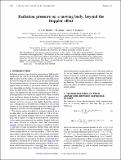Radiation pressure on a moving body : beyond the Doppler effect
Abstract
The dependence of macroscopic radiation pressure on the velocity of the object being pushed is commonly attributed to the Doppler effect. This need not be the case, and here we highlight velocity-dependent radiation pressure terms that have their origins in the mixing of s and p polarizations brought about by the Lorentz transformation between the lab and the material rest frame, rather than in the corresponding transformation of frequency and wavevector. The theory we develop may be relevant to the nano-optomechanics of moving bodies.
Citation
Horsley , S A R , Artoni , M & La Rocca , G C 2012 , ' Radiation pressure on a moving body : beyond the Doppler effect ' , Journal of the Optical Society of America B : Optical Physics , vol. 29 , no. 11 , pp. 3136-3140 . https://doi.org/10.1364/JOSAB.29.003136
Publication
Journal of the Optical Society of America B : Optical Physics
Status
Peer reviewed
ISSN
0740-3224Type
Journal article
Description
The Engineering and Physical Sciences Research Council (EPSRC) provided financial support for this research.Collections
Items in the St Andrews Research Repository are protected by copyright, with all rights reserved, unless otherwise indicated.

